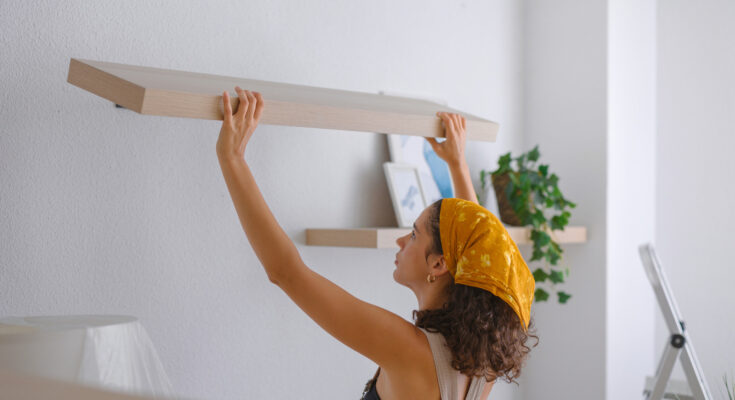Foolproof Tips And Tricks For Hanging Shelves Without The Hassle
We may receive a commission on purchases made from links.
It doesn’t take a mastermind to hang a shelf and doing so is considered a beginner project. Although shelving is regarded as one of the easier furniture assembly jobs, you shouldn’t go in blind. Without any prior experience or knowledge, minor mishaps are inevitable, but you can avoid a lot of mistakes by following a few simple tips and tricks. Take advantage of layman and professional hacks to keep basic shelving jobs from becoming a hassle.
Below are eight tricks to keep in mind before hanging shelves. A surprising number of things can go wrong if this task isn’t approached strategically. Shelves can be uneven or without proper support, leading to unnecessary damage to your walls, shelf unit, and its contents. Another risk is hanging them too close or far apart, leading to an unattractive and permanent display tacked to the wall. Don’t leave the success of your handiwork up to chance; not when resourceful shelving knowledge is only a few mouse scrolls away. Read on to learn how to put up shelves correctly, as well as some helpful tools that can assist throughout the process, and some (safe) shortcuts you can take.
Keep shelves even using painter’s tape to mark where screws go
The key thing to get right when mounting any type of shelf is making sure it is level, and there’s an easy Property Brothers-approved trick for perfectly-hung floating shelves. Use a strip of painter’s tape to mark where to drill the holes for the hardware. This ensures your holes are spaced correctly, and you don’t make any unnecessary and unsightly extra marks or holes in your paint or wallpaper.
Simply lay a strip of painter’s tape along the back of your shelf, trimming it to the exact dimensions of the shelf. Mark where the screws or supports are located with a pencil or pen on the tape, and transfer the tape to the wall where you intend to hang the shelf, using a spirit level to make sure the tape is level (which will ensure the screws are at the same height). While you’ve got your painter’s tape out, here’s a bonus tip: Take another piece of painter’s tape, stick it below the one that has your hole placement marks, and curl the top so some of the sticky side is facing up. The exposed sticky portion should help catch dust and debris while drilling, stopping most of it from dirtying the floor or surrounding furniture.
You can find painter’s tape at most big-box and home improvement stores. The most reputable painting tape is ScotchBlue’s Original Multi-Surface Painters Tape, 1 Inch Wide, which comes with over 60 yards of tape, giving you plenty of tape for trial and error, as well as other projects. If you want to do the trick that catches fallen wall dust too, ScotchBlue’s Original Multi-Surface Painters Tape, 2 Inch Wide is twice as thick, providing an even bigger sticky trap.
Utilize double-headed picture hanging pins instead of traditional screws for light-weight shelves
Shelves add depth and personality to a room, but often at the cost of damaging your walls with their supports. Many rental agreements outright ban screwing items onto walls, so tenants must get creative with their workarounds. Install a small shelf while causing minimal damage by using double-headed picture hanging pins instead of traditional screws. Picture nails have a thin needle-like point that inserts into your walls and thick heads for hanging strings or twine from. You can hang light shelves like Chihutown’s Wood Hanging Shelves for Walls from them without creating as much damage as traditional screws or nails would.
Although you can use traditional thumbtacks, they aren’t as sturdy, so we’d recommend spending a few more dollars for something like the Mr. Pen Double Headed Picture Nails or these Ferraycle Double Headed Picture Hangers which come in packs of various sizes, and the largest is supposed to be able to hold weights of up to 50 pounds. Be sure to factor in both the weight of the shelf and any items you want it to hold. Since the butt of the pin is slightly visible, you should pick a finish that meshes with the rest of your interior design theme.
Squeeze out two dots of toothpaste to mark where to make holes for screws
Sometimes, the most unlikely items can make hanging wall shelves a breeze. Try the same weird toothpaste hack for perfectly hanging shades, and put two dots of toothpaste on the back of a shelf where the brackets will be attached. Press the toothpaste and shelf into your wall, possibly using a level to make sure it’s standing evenly across. When you remove the shelf, the toothpaste should mark where you need to drill. This ensures holes are in the right place, minimizing damage and guesswork while installing.
The beauty of this hack is that you can use toothpaste you already have on hand. If you want to avoid staining white walls with the dyes found in many toothpaste brands, use something like Colgate Cavity Protection Regular Fluoride Toothpaste, which is a pristine white color. However, if you’re less worried about staining the walls and want to ensure there are visible marks left by the toothpaste, something colorful like Aquafresh’s Cavity Protection Toothpaste that has swirls of blue and red will be hard to miss while hanging shelves.
Create a visual aid with a laser level to mark the wall
Using a level when mounting shelves is key — without one, there’s no way of making 100% sure you’re mounting them straight. Even if you have a good eye, other elements that aren’t plumb can throw off your judgment. While a spirit level will definitely get the job done, a laser level can make things even easier. With a bubble level, you have to hold it up against the wall to check whether your screw holes are level. This can often mean a bit of juggling, even if you use the aforementioned tape hack — you might have to readjust the tape a couple of times, putting down the level in between, until you get things perfect. A laser creates a red line from afar, shining a light on the wall and allowing for hands-free operation. You simply stand erect the laser level, turn it on, and angle it to where you want the shelf, and it will place a straight, level line on the wall, which you can then use as a foolproof guide for drilling your holes. All you have to do is space them right width apart on the projected line.
Laser levels are sold at most big-box stores and home improvement chains and while they generally are more expensive than standard, non-electronic versions of these tools, you can pick up super cheap versions like QPEUIM’s Laser Level Tool. Or, if you’re planning a lot of DIY work and want a pro-grade option that’s more versatile, look for a tripod version like ASOBRIS’s Green Cross Line Laser. Finally, if you’ve got lots of items to mount, don’t mind spending a bit extra, and want an even more convenient device, go for one that can adhere to the wall, like the Ryobi 20′ AirGrip Laser Level from Home Depot.
Keep a gap of 10 inches or more between floating shelves
If you’re installing multiple shelves above each other, another tip that can save a ton of time and frustration is determining the right amount of space to put between your floating shelves before you start drilling. Too little space impedes the function, as you won’t be able to fit taller objects in the bottom and middle shelves. It also clutters the aesthetic, creating an unattractive setup. Standard shelves for bookshelves are between eight to twelve inches apart, and you should follow a similar setup to emulate the spacious and practical appeal of bookshelves. However, if you have any particularly tall items you want to store or display, measure these, and adjust the space between your shelves accordingly. One of the tips for styling floating shelves to create a gorgeous design is to combine items with various heights, so taking time to make sure those tall books or lofty pottery vessels will fit is well worth it.
Use a standard tape measure to put ample space between shelves before drilling or hammering away. If you want a more specialized device, there are combination levels and tape measures designed for hanging items like standalone shelves. Try the GCXIXPY All in One Picture Hanging Tool Kit with Level if you want a two-in-one tool to help position shelves evenly and in a design-conscious manner. Also, don’t forget to factor in the actual width of the shelves. For instance, if you’re installing thick floating shelves, you may need an extra inch of distance between the mounting hardware for each shelf to fit those taller books, bins, or decor pieces in comfortably.
Hang floating shelves with adhesive strips, but only if they are designed for this mounting method
The best shelves for renters leave even less damage behind than tacks. Command makes small but sturdy hanging L-shaped shelves and ledges with adhesive backings. Using their reputable adhesive strips, this brand’s shelving hangs without requiring any power tools or time spent drilling holes and hammering in drywall anchors. Simply peel off the adhesive backing, line up the shelf with the wall (being sure to clean the area with rubbing alcohol), make sure it is level, and press it down for about 30 seconds. You will also need to wait a couple of hours for the adhesive strips to fully bond to the wall before placing items on the shelf.
The caveat is that these shelves only hold lightweight objects between two and five pounds, since they’re solely held up by adhesive instead of hardware. Also, we wouldn’t recommend mixing the adhesive Command strips with other shelving, as this might throw off the weight capacity and hold on the wall. The Command shelves are lightweight, and the back is designed for good contact between the adhesive strips, the shelf, and the wall.
Command products are widely popular and found at most major retailers. There are two shelves to choose from: a 21-inch Command Store Picture Ledge or a smaller 4-inch Command Store Display Ledge. The longer option holds up to 5 pounds, while the smaller ledges only hold up to 2 pounds, making them best-suited for minimalist displays or small household items like keys. There are limited color options, and the Command Store offers quartz (white) or slate (black).
Use a carbide drill bit when hanging shelves on tiled walls
Installing a shelf over a tile wall or backsplash takes more care than you may realize. Any good guide to installing shelving over tiled walls will stress how important it is to use the right tools when drilling into a backsplash or tiled wall. Ceramic can crack if you don’t use the right drill bit, leaving you with an unsightly, botched job that’s a headache to fix — if you can fix it at all. While you can pry up and replace cracked tiles, you might not have a matching one to install in its place. To avoid all of this, one of the first steps to ensure no cracks when installing shelves on a tile backsplash is to use a carbide drill bit.
Diamond carbide drill bits work with any regular drill and, like many other products in this list, can be found at most big-box and home improvement stores. Get a single quarter-inch Dewalt Tile Drill Bit, Diamond Tip, or a smaller size depending on the size of the screws or rods you will be mounting the shelf with. If you have plans to mount more furniture or decor in other tiled areas in your home, invest in a full set (like the DKibbith 8 Pack Diamond Drill Bits Set) to ensure you have the right drill bit sizes for various projects. If you have any masonry walls in your home, carbide drill bits can also come in handy for mounting items on them, as they’re designed to drill through tough materials like brick and concrete.
Download a helpful level app if you don’t have a physical spirit level on hand
We’ve already covered two types of levels, but what if you have neither, and are itching to quickly put up a few shelves? Instead of putting off the project for yet another weekend, wasting time driving to a hardware store just to buy a spirit level — or worse, trying to eyeball the level — as the saying goes, “there’s an app for that.” Apple products come with spirit level apps pre-installed, and Android users can download a level app of their choice from the Google Play Store. Once the app is open, simply hold your phone against the wall, and follow any instructions.
If you have an Apple phone, look for the “Measure” app. Android users can pick between a bunch of free apps: The highest rated free option is the Bubble Level – Level Tool by Simple Design Ltd. All you need is a few megabytes of spare storage. Be warned, the Android apps may have one-time ads, but according to reviewers, they are short and aren’t any more inconvenient than going out and buying a level. As far as accuracy goes, spirit level apps probably aren’t as precise as a physical bubble level or laser level, but a well-rated one should be adequate in a pinch.



